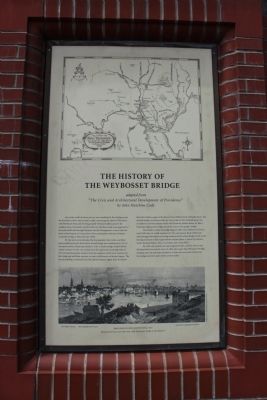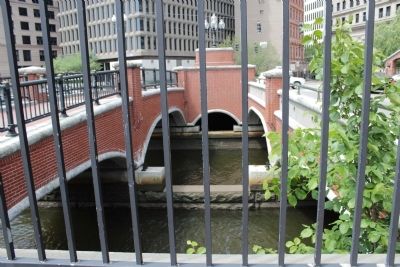The History of The Weybosset Bridge
The Civic and Architectural Development of Providence
by John Hutchins Cady
Just to the north of where you are now standing the first bridge across the Providence River was erected in 1660, connecting the shore of the Neck with Weybosset Neck and the Pequot path which provided access to the meadow lands. Previously, a ford in the river had been used as an approach to that path which led through Pawtuxet and the Narragansett country into the lands of the Pequots in Connecticut. Poor construction and lack of repairs caused the bridge to fail in the late 1670's.
For the next several decades the townspeople, their cattle, and their teams waded across the ford until a second bridge was constructed in 1711. It was destroyed by a flood and rebuilt in 1719. A fourth bridge, funded by the colony's lottery in 1745, was carried away by a gale and record high tides in 1761. During those years, farmers from the meadows to the west crossed over the bridge and sold their produce in what is still known as Market Square. The first drawbridge, constructed in 1764, allowed square rigged ships to unload their West Indies cargos at the Bowen Street Wharf north of Steeple Street. The seventh bridge was destroyed by the great gale of 1815; its flood waters are recorded on a bronze plaque on the wall of nearby Market House.
In 1816 a fixed type replacement closed the cove to "sea going" vessels.The trend to widen the bridge began in 1843 and continued in earnest until 1940 when its width reached 1147 feet and Guiness Book of Records acknowledged Providence as having constructed the widest bridge in the world. During its history it has supported two market places, Central Fire Station, Union Railroad Depot, Horse Car Depot, and a post office.
By 1983 only parked cars and congested traffic could be seen on the decking which covered the river. In 1984, after more than 300 years of bridge building, the city and state decided to reclaim the rivers and constructed the bridges and river park which are here today.
Topics. This historical marker is listed in these topic lists: Bridges & Viaducts • Colonial Era. A significant historical year for this entry is 1660.
Location. 41° 49.531′ N, 71° 24.505′ W. Marker is in Providence, Rhode Island, in Providence County. It is in College Hill. Marker is on College Street, on the right when traveling west. Touch for map. Marker is in this post office area: Providence RI 02903, United States of America. Touch for directions.
Other nearby markers. At least 8 other markers are within walking distance of this marker. Around the Corner from Market Square (here, next to this marker); The Hurricane of September 21st 1938 (a few steps from this marker); United States Merchant Marine Memorial (within shouting distance of
Credits. This page was last revised on February 8, 2023. It was originally submitted on June 16, 2012, by Bryan Simmons of Attleboro, Massachusetts. This page has been viewed 686 times since then and 58 times this year. Photos: 1, 2. submitted on June 16, 2012, by Bryan Simmons of Attleboro, Massachusetts. • Bill Pfingsten was the editor who published this page.

